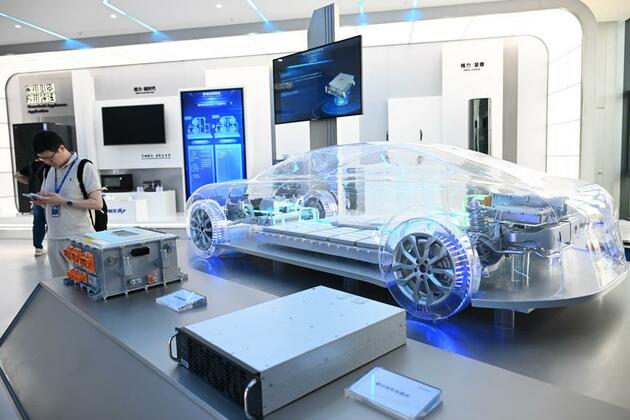Column: Protecting intellectual property rights: China in action
Xinhua
11 Jul 2025, 13:45 GMT+10

by Hua Gesheng
Protecting intellectual property rights (IPR) needs global cooperation. Unfortunately, some countries have deliberately painted China as a technology thief, baselessly accusing it of forced technology transfers and weak IPR enforcement.
But these claims ignore a fundamental truth: China is not a copycat economy -- it is a nation capable of innovation and skilled in governance.
INNOVATION, NOT INFRINGEMENT
China's rise in technology is not a result of theft, but of decades of investment in talent, science and infrastructure.
In 2024 alone, China's R&D spending exceeded 3.6 trillion yuan (about 0.5 trillion U.S. dollars), making it the world's second-largest investor in research and development. With the number of full-time equivalent R&D personnel exceeding 6 million and an annual output of 5 million STEM graduates, China has built an impressive engine of innovation. According to the Global Innovation Index 2024 released by the World Intellectual Property Organization (WIPO), China has risen to the 11th place globally on innovation, making it one of the fastest-improving economies over the past decade.
China now leads globally in fields such as 5G, high-speed rail, green energy, and drones -- not because it stole technology, but because it created its own. As former U.S. Secretary of the Treasury Larry Summers acknowledged, China's strength lies in its commitment to basic science and education, not in intellectual property theft.
Even U.S. tech giants like Apple, Google and Amazon have confirmed in congressional hearings that there is no evidence of Chinese theft of American technology. Ironically, China's institutions remain frequent targets of cyberattacks by U.S. intelligence agencies, according to the National Computer Virus Emergency Response Center of China.
A LEGAL SYSTEM THAT WORKS
A truly strong state is not one that shouts the loudest, but one that governs the best. In recent years, China has built a robust legal framework for IPR protection that aligns with international standards. It features punitive damages for infringement, specialized IPR courts and equal protection for domestic and foreign enterprises alike.
Foreign companies are taking notice. Apple, for instance, earns billions from intellectual property embedded in devices assembled in China and recently increased its R&D spending in the country by 22 percent. Pharmaceutical giant Pfizer has built three R&D centers in China, while Medtronic and Otis have also made China their innovation hub.
A landmark example came from the Shanghai Intellectual Property Court, which ruled in favor of Tesla in a trademark dispute, demonstrating that foreign firms can expect fair and effective protection under Chinese law.
As French magazine L'Express observed, China has gone from being an IP "laggard" to a "model student."
VOLUNTARY COOPERATION, NOT COERCION
Another frequent misrepresentation is the claim that China engages in "forced technology transfers." In reality, Chinese law explicitly prohibits this practice. China has significantly relaxed foreign investment restrictions -- reducing the national negative list from 190 items to just 29 (and 27 in free trade zones). The manufacturing sector is now almost entirely open to foreign capital.
These reforms empower companies to enter joint ventures or technology-sharing arrangements based on commercial interest and mutual benefit -- not coercion. The United States, however, often labels such voluntary cooperation as "forced transfer," a mischaracterization that ignores basic facts.
The real examples of coercion lie elsewhere. It is the United States that has pressured foreign companies like Samsung and SK to disclose core technologies as a precondition for doing business in the United States, and has demanded that ByteDance sell TikTok and relinquish control of its algorithm -- moves that many experts view as state-enforced technology expropriation.
A CAPABLE AND RESPONSIBLE INNOVATOR
China's path to modernization is powered by innovation, governed by law, and guided by the principle of mutual benefit. It is not driven by theft, coercion or manipulation.
The next time someone tells you that China doesn't respect intellectual property, ask them this: Why do so many top innovators choose to invest in China? Why do they grow and thrive under China's legal framework?
Don't just believe the headlines -- go see for yourself.
Editor's note: Hua Gesheng is a commentator on international and multilateral affairs, writing regularly for Xinhua News Agency, Global Times, China Daily, CGTN, etc. She can be reached at [email protected].
The views expressed in this article are those of the author and do not necessarily reflect the positions of Xinhua News Agency.
 Share
Share
 Tweet
Tweet
 Share
Share
 Flip
Flip
 Email
Email
Watch latest videos
Subscribe and Follow
Get a daily dose of Wisconsin Star news through our daily email, its complimentary and keeps you fully up to date with world and business news as well.
News RELEASES
Publish news of your business, community or sports group, personnel appointments, major event and more by submitting a news release to Wisconsin Star.
More InformationInternational
SectionGaza War sucking life out of an Israeli generation
In the past month alone, 23 Israeli soldiers have been killed in Gaza—three more than the number of remaining living hostages held...
Faulty IT system at heart of UK Post Office scandal, says report
LONDON, U.K.: At least 13 people are believed to have taken their own lives as a result of the U.K.'s Post Office scandal, in which...
Travelers can now keep shoes on at TSA checkpoints
WASHINGTON, D.C.: Travelers at U.S. airports will no longer need to remove their shoes during security screenings, Department of Homeland...
Rubio impersonator used AI to reach officials via Signal: cable
WASHINGTON, D.C.: An elaborate impersonation scheme involving artificial intelligence targeted senior U.S. and foreign officials in...
Warsaw responds to migration pressure with new border controls
SLUBICE, Poland: Poland reinstated border controls with Germany and Lithuania on July 7, following Germany's earlier reintroduction...
Deadly July 4 flash floods renew alarm over NWS staffing shortages
WASHINGTON, D.C.: After months of warnings from former federal officials and weather experts, the deadly flash floods that struck the...
US Sports
SectionAs Rays struggle, Red Sox aim for eighth straight win
(Photo credit: Eakin Howard-Imagn Images) The Boston Red Sox are feeling good. After sweeping back-to-back cellar dwellers in the...
Tigers All-Star Tarik Skubal opens series vs. Mariners
(Photo credit: Ken Blaze-Imagn Images) Tarik Skubal had his final start before the All-Star break moved up. The Seattle Mariners...
Yankees enter series with Cubs on high after comeback win
(Photo credit: Matt Marton-Imagn Images) Pete Crow-Armstrong enters his first trip to Yankee Stadium as a member of the 25-25 club...
Fernando Tatis Jr., Manny Machado power Padres past D-backs
(Photo credit: Denis Poroy-Imagn Images) Fernando Tatis Jr. and Manny Machado each homered as the San Diego Padres beat the visiting...
Seven-run inning propels Rangers past Angels
(Photo credit: Jayne Kamin-Oncea-Imagn Images) Marcus Semien went 4-for-5 with an RBI and three runs scored and Adolis Garcia homered...
Tyler Soderstrom's 4 RBIs lead A's past Braves in 11
(Photo credit: Sergio Estrada-Imagn Images) Tyler Soderstrom hit a three-run homer early and concluded the contest with a walk-off...













